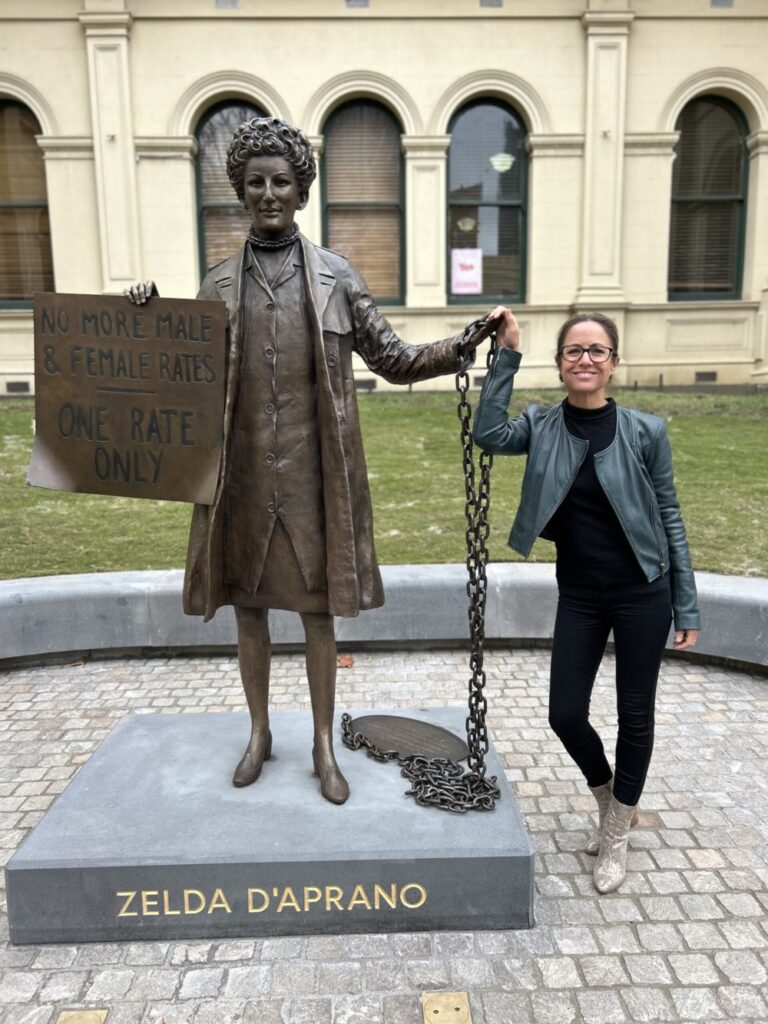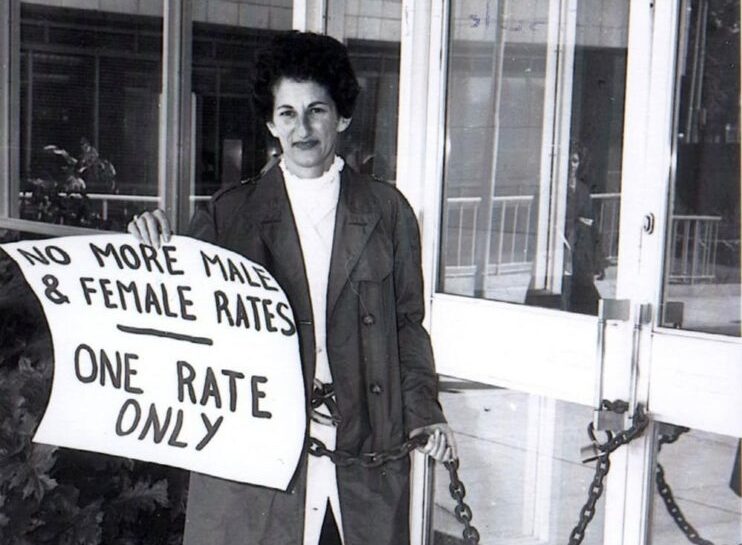A few days ago at Trades Hall Council on Lyon Street, Melbourne, the late feminist Zelda D’Aprano was immortalised in bronze statue created by artist Jennifer Mann. Zelda’s most famous act was chaining herself to the doors of the Commonwealth building in 1969 to call for equal pay for women. That was but one act, among many.
Zelda’s statue didn’t pop up by accident. Historian Professor Clare Wright co-convenes of the group called A Monument of One’s Own – which aims to address the gender balance of statues. Clare helped campaign and fundraise for the statue.
Professor Wright spoke at the statue’s unveiling. Her lightly edited speech follows.
I’d like to start by acknowledging that we gather today on the unceded stolen land of the Wurundjeri people, and paying my respects to their elders, past and present. Vote Yes.
I’d also like to thank Julie Gillard and Natalie Hutchins for their esteemed presence and fine words today, and to shout out to my co-convenor at A Monument of One’s Own, Kristine Ziwica, as well as our comrades at Trades Hall and of course the magnificent artistry of Jennifer Mann, as well as all the advocates, activists, artisans and donors who have made this day possible.
The creation of this statue of Zelda D’Aprano is a critical act of commemorative justice in Australia, where less than 4% of statues depict women. [in Melbourne, only 11 of 582 statues are full bodied named – not allegorical – women.]
Others today have spoken about why Zelda and her actions matter.

Professor Clare Wright and the statue of activist Zelda D’Aprano at Trades Hall. Picture: Supplied
I want to say something about why a statue – that stolid remnant of patriarchal colonial white supremacy – also matters. And in particular, why this statue that Jenn [Mann] has rendered so beautifully, so meticulously, matters.
I first met Zelda in 2017. I was interviewing her for a Radio National history series I then presented about history and photography. On this occasion, I was delving into the now iconic photograph of Zelda chained to the front of the Commonwealth Buildings in Melbourne in October 1969, co-incidentally the year of my birth.
I learnt many things on that day. I learnt about how the idea for her chain-up, as she called it, came into being; how she did it on her lunch break; how her mates in the maritime union bought her the heavy chain; how she was modelling her action after the Australian suffragist Muriel Matters, who had chained herself to the Grille of the Ladies Gallery at the British House of Commons in 1908, proclaiming Votes for Women. [Now there’s a woman who deserves a statue; I’m looking at you Adelaide]
I learnt how Zelda made the clothes she was wearing that day; how she didn’t have anything to drink for hours before the protest for fear she’d have to go to the loo while affixed to the front of a building.
Importantly, I learnt how Zelda herself tipped off the press and made sure a photographer would be present to witness and capture her maverick action. It is one of the reasons we were so keen to transform that photograph into bronze, literally, because that is how Zelda herself wanted to be remembered. For a woman to craft and stage manage her own media image is a rare act of sovereignty indeed.
Zelda’s famous action in 1969 saw her occupying public space in a way that was counter to the prevailing norm of women as silent, demure and inconspicuous. It is fitting that she will now occupy a permanent space in our civic landscape, a concrete – or at least bronze – reminder that women have always had to fight for the rights and freedoms we enjoy today.
By honouring Zelda’s work in this way, we honour all women who collectively have struggled for equal pay, wage justice and the entitlement to be heard.
Zelda’s statue will also provide a timely reminder that the fight is not over, that as a nation we must continue to address the unfinished business of the gender pay gap and the sexism women still face in the workplace and society more broadly.
We hope the statue will motivate people to go back to the barricades to achieve wage justice for women. Women’s economic security – and therefore their power, their freedom – depends on it.
At a Monument of One’s Own, we believe that who we remember and how we remember them matters. Who we put on a pedestal matters, because for all their flawed legacy as tools of colonialism, we know how to read figurative statuary. We know statues symbolise power. That’s why we deface them and pull them down.
The power to take up space.
The power to leave a permanent record of achievement and enterprise.
Monumental change in the visibility, credibility and civic recognition of women is happening, one statue at a time. Closing the commemorative gap will help us close the respect gap that we know leads to other forms of violence and discrimination against women.
But you’ll also see that Zelda doesn’t tower above us, proclaiming and commandeering space. Her pedestal is culturally symbolic but not physically lofty. She is down here with us, arms outstretched, unfurling her chains, welcoming all comers, welcoming the fight.
At the base of the statue are engraved the response that Zelda gave to a man who said to her that ground-shifting day in 1969, ‘what can one woman hope to achieve’. Zelda replied: Today it was me, tomorrow there will be two of us, the next day there will be three and it will go on and on and there won’t be any stopping it.
Here’s an idea.
Let’s join Zelda in the fight, eh? Because together it WILL go on and on and there WON’T be any stopping it.
- Picture at top: Zelda D’Aprano’s Equal Pay protest. Picture: ACTU. Find the original here.
Clare Wright is Professor of History and Professor of Public Engagement at La Trobe University. She is co-convenor of A Monument of One’s Own, a NFP national advocacy body for statue equality.





